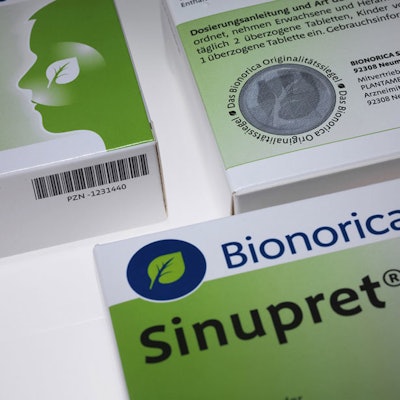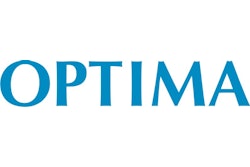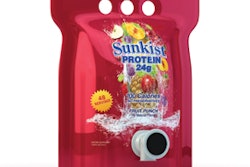One of every 20 medications is tainted in Germany, where counterfeit medications are rapidly increasing. Researchers are therefore developing authenticity seals and security codes intended to make drug packaging uniquely identifiable.
Anyone who buys Sinupret sinusitis pills from pharmaceuticals producer Bionorica will notice that its folding carton includes a three-dimensional, optically variable embossed mark, which can be seen in relief when the carton is tilted. Since the herbal medication was so often copied, Bionorica engaged the Munich-based Giesecke & Devrient, which specializes in printing bank notes, to design this tangible security feature for Sinupret.
Artur Theis, a subsidiary of the Edelmann Group, developed the production process for the new packaging. The mark is printed and embossed by Braun Pharmadruck, also an Edelmann subsidiary. Sinupret, one of the most popular products for treating colds, is just the start. By the end of 2011, Bionorica intends to emboss the packaging for all of its products with the new seal. “We want to provide the best possible safeguards for pharmacies and users,” says company head Michael Popp.
Producers who have problems with counterfeiters must make their products uniquely identifiable. This is especially true in the pharmaceutical sector. “The danger of counterfeit medication is growing,” states Ulrike Holzgrabe of the German Pharmaceutical Society (DphG). Although producers of pharmaceuticals experience losses amounting to billions of Euros each year through product piracy, this is not the main problem, since counterfeit medications threaten the health or lives of unsuspecting patients.
The Internet is a weak spot
According to EU figures, the German customs authorities seized counterfeit medications worth 11.5 million Euros in 2009--30% more than in the previous year. In addition, a World Health Organisation (WHO) study claims that even in supposedly safe regions such as Europe and the U.S., up to 10% of all medications are counterfeit.
According to Holzgrabe, the proportion of such counterfeit products in Germany is about 5%. “But this is just the tip of the iceberg,” she suspects. Mail order business offers criminals the greatest opportunities. This sector is booming, especially in Germany. Marketing research firm ACNielsen estimates that sales of non-prescription drugs increased by a quarter last year. According to the consumer research consultancy company GfK, one in four Germans now obtain medications by mail order. At the same time, it is apparently becoming harder for consumers to distinguish between reputable mail order pharmacies and illegal traders. Test purchases by the Central Laboratory of German Pharmacists confirm counterfeiting rates of 50% for medications sold by illegal Internet pharmacies, for example.
“Producers of pharmaceuticals are therefore more willing to look for methods to provide better security against counterfeiting,” says Holzgrabe. The companies have two aims: consumers, who should be able to verify that they have received an original product; and experts that should be able to identify counterfeits when they do inspections.
The most active companies include not only medicinal plant specialist Bionorica but also Bayer Healthcare, whose products are among the most frequently counterfeited worldwide. The company therefore explains on its Web site how patients can distinguish between original Bayer preparations and imitations. In the future, Bayer Healthcare will also provide its medication packaging with counterfeit-proof features. The Leverkusen-based company has also engaged Artur Theis for this project. “Our task is to make the security features suitable for a folding carton production line, and then for series production,” explains Ulrich Dörstelmann, head of the counterfeiting security department at the Edelmann subsidiary.
Based on banknote printing
In Germany, Artur Theis is regarded as the specialist for folding cartons that cannot be copied. The conditions in its Wuppertal plant, which has been converted into a counterfeiting security facility, are the same as those in a banknote printing company: there is strict access control to the production section, the security zones are off limits for most of the personnel and all processes are documented and archived. The result of the cooperation with Bayer Healthcare is a sort of lenticular image that cannot be imitated by counterfeiters.
The EU, however, requires yet another step to be taken by the pharmaceuticals industry to ensure greater patient safety. Industry Commissioner Günter Verheugen announced that in 2011 a standard procedure will be employed at the EU level in the fight against the counterfeit medications. In 2008, the Commission proposed that medication packaging should be protected by a security mark and that in that future it should be possible to retrace their path from the counter back to the factory. The WHO is also a strong supporter of counterfeit-proof labeling. Producers of pharmaceuticals are therefore pushing for the introduction of an electronic proof of origin in form of a track-and-trace system, with which the complete supply chain can be monitored.
In order to test and demonstrate coding and identification solutions, the European Federation of Pharmaceutical Industries and Associations (EFPIA) launched a pilot project in Sweden in September 2009. For several weeks, medication packaging for 25 pharmacies in the Stockholm region were provided with a two-dimensional data-matrix code that can hold more information than a simple bar code. In the Swedish project, it contained an article number, a batch number, a use-by date, and a serial number. At the pharmacy, the code was scanned and compared immediately with an entry in a database. The whole process took only a few seconds, so that counterfeits were immediately identified. Only after this security check did the customer receive the medication. About 100,000 medication packages were tested using this system--with great success, the EFPIA reported.
Origin checks by scanner
Experts expect the track-and-trace system to be implemented throughout Europe in the near future. Manufacturers of machinery and systems are prepared for a switchover. For example, Optima Group Pharma, which specializes in filling and sealing syringes and vials, offers coordinated track-and-trace solutions for producers of pharmaceuticals. “Ready-to-use syringes are stored and transported in special syringe nests in plastic boxes referred to as tubs. Our machines label the containers, so that they can be traced at any time,” explains company spokesman Henning Felix.
Bosch Packaging Technology, which supplies filling, processing and packaging technology for the pharmaceutical industry, also has printing and tracing equipment in its portfolio. Bosch Product Manager Daniel Sanwald explains that each minute, up to 400 folding cartons are transported on a conveyor belt through a printer, which labels each carton with a data-matrix code containing a production number, use-by date, and serial number. A camera subsequently checks and verifies the code. The data are stored on a high-capacity central server, from which they can always be called up. If a product that cannot be identified in this way turns up in a pharmacy, it must be a counterfeit.
A security offensive by producers of pharmaceuticals would also increase demand for high-quality packaging materials producers. In order to cut costs during the economic crisis, many companies bought packaging and packaging components that may have been of questionable quality.
“All those who subscribe to patient safety and who want to send a clear signal that quality is a top priority, will no longer use these products in the future,” says Peter Rösch, head of sales at atomiser pump manufacturer Aero Pump.
It is unlikely that pharmaceutical counterfeiters will be attracted by medications that have been provided with a security mark, a code and top quality packaging. However, there are still many obstacles on the path to obtaining maximum patent protection. An enormous investment is required in order to retool packaging lines and this could prevent pharmaceutical companies from acting quickly. Even if the EU rapidly approves its pharmaceutical packages, the implementation process could take years. Another aspect that has yet to be clarified is where all the data associated with a pan-European track-and-trace system should be stored. Will there be several geographically dispersed servers or one central system? “And then someone must be the owner. This raises the question of who trusts who?” remarks Bosch’s Sanwald.
This article was supplied by interpack Trade Fair. For more information on the May 12-18, 2011 event, visit their Web site.






























